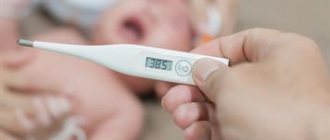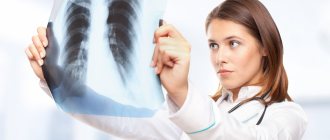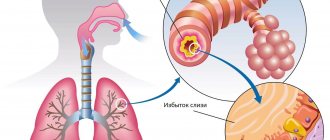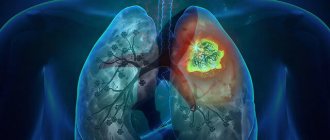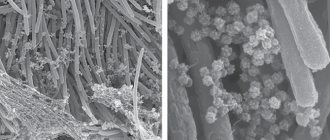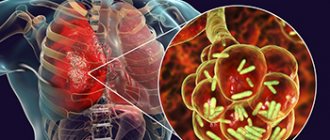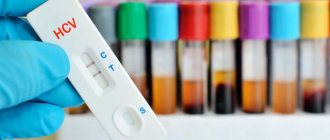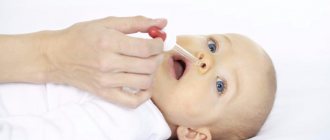Currently, community-acquired pneumonia remains the most important socially significant infectious disease of the urban population of all ages and professions. In this regard, an integrated approach to providing care to patients is one of the main tasks of medical organizations. Despite the fact that today the main method of treating community-acquired pneumonia remains timely antimicrobial therapy, diet also plays an important role in the complex of treatment measures.
author: V.V. Korenkov Ph.D., senior researcher at the State Scientific Center of the Russian Federation Federal State Budgetary Institution "Federal Medical Biophysical Center named after A.I. Burnazyan"
Total information
Pneumonia is a group of acute infectious diseases, different in etiology, pathogenesis, and morphological characteristics, characterized by focal damage to the respiratory parts of the lungs with the obligatory presence of intra-alveolar exudation. Conventionally, pneumonia can be divided according to the place of its occurrence - community-acquired, nosocomial (hospital-acquired), and also those occurring in persons with immunodeficiency conditions.
Community-acquired pneumonia
Community-acquired pneumonia should be understood as an acute disease that arose in a community setting, that is, outside the hospital or later than 4 weeks after discharge from it, or diagnosed in the first 48 hours from hospitalization, accompanied by symptoms of lower respiratory tract infection and radiological signs of fresh focal infiltrative changes in the lungs in the absence of an obvious diagnostic alternative.
Mortality from community-acquired pneumonia is the lowest (1–3%) in young and middle-aged people without concomitant diseases. On the contrary, in patients over 60 years of age with serious concomitant pathologies (chronic obstructive pulmonary disease, malignant neoplasms, alcoholism, diabetes mellitus, kidney and liver diseases, cardiovascular system, etc.), as well as in cases of severe community-acquired pneumonia, this indicator reaches 15–30%.
The etiology of community-acquired pneumonia is directly related to the normal microflora that colonizes the upper respiratory tract. Of the numerous microorganisms, only some with increased virulence are capable of causing an inflammatory reaction when they enter the lower respiratory tract. Among other causative agents of community-acquired pneumonia, respiratory viruses (influenza viruses type A and B, parainfluenza, adenovirus and respiratory syncytial virus) are often mentioned, but in reality they rarely cause direct damage to the respiratory parts of the lungs, being a kind of conductor of bacterial infection.
Danger of pneumonia
The main danger of pneumonia is that the smallest structural units of the lung tissue, the alveoli, are damaged.
Alveoli - microscopic “bubbles” - are normally filled with air, this is where the main gas exchange occurs: the blood is enriched with oxygen and gets rid of carbon dioxide.
In pneumonia, the alveoli become filled with inflammatory fluid and are unable to perform their basic functions.
If a significant part of the lung tissue is affected:
- the body stops receiving the required amount of oxygen, acute respiratory failure develops, intoxication increases - poisoning with unresolved carbon dioxide and other metabolic products.
Therefore, disruption of the lungs becomes a problem for the whole organism and can lead to the most unfavorable consequences. As doctors say: “Problems with the lungs are never easy.”
Cause of pneumonia
The clinical picture of the development of pneumonia is very diverse. It is determined by many factors, such as the type of pathogen, the degree of its activity, the localization of the inflammatory process, the extent of its spread, the state of immunity of the sick person, his age, the presence of concomitant diseases and much more.
Pneumonia can occur as an independent disease (primary) or as a complication of other diseases (secondary). However, the cause of the disease is almost always an infection (bacteria or virus).
Pathogenic microorganisms themselves cannot cause pneumonia; for this there must be provoking factors that weaken the general immunity of the body or the local immunity of the respiratory tract.
List of causes of pneumonia
- Acute respiratory viral infection
- The presence of a chronic inflammatory process in the lungs (chronic bronchitis)
- Hypothermia
- State of prolonged stress
- Smoking
- Presence of chronic diseases
- Injuries
- Surgical interventions
- Elderly age
- Obesity
- Physical inactivity
- Alcohol abuse is also considered a risk factor for pneumonia.
Therapeutic nutrition for respiratory diseases: basic rules
The role of nutrition in the treatment and prevention of respiratory diseases should not be underestimated. Scientists have already proven that with a protein-energy deficiency in the diet, the functions of the muscles of the respiratory organs are disrupted, gas exchange in the lungs worsens, and the body’s immune system begins to suffer.
In addition, local immunity of the mucous membrane of the lungs decreases, which leads to complications of acute respiratory viral infections and increases the likelihood of developing pneumonia and other respiratory diseases against the background of a viral or bacterial infection.
A low calorie diet, especially a deficiency of high-quality proteins, impairs the production of surfactant, a substance that lines the lung alveoli from the inside. But it is he who performs an important bactericidal and immunomodulatory function in the lungs and forms the necessary anti-edematous barrier.
Simply put, to prevent diseases of the respiratory system and complications during respiratory diseases, it is important to maintain the required caloric content of the diet and the proportion of high-quality proteins in it.
In this case, you need to focus on the right fats and ensure that the amount of simple carbohydrates does not exceed the permissible limits. Be sure to increase the intake of vitamins and minerals that affect the respiratory system: vitamin C, A, D, zinc, calcium, magnesium, phosphorus, copper.
How to eat when you have pneumonia
Nutrition for pneumonia should be aimed at maintaining the body's immune defense and reducing intoxication. All food should be easy to digest, not cause bloating, and contain as little saturated animal fat and cholesterol as possible. Salt intake is limited to 6-8 g per day. The amount of simple sugars is also reduced as much as possible.
It is better to take food warm, in small portions 5-6 times a day, all dishes are steamed or boiled. In the first days of illness, food should be crushed, pureed or given in semi-liquid form.
A special role in the diet for pneumonia is played by foods that are sources of calcium, primarily milk, cottage cheese, and cheese. It is very important that the diet contains a sufficient amount of protein, vitamins and microelements. To reduce intoxication, drinking plenty of fluids (1.5 - 2 liters per day) is recommended.
What does the rehabilitation program include?
When starting work on restoring the body, it is necessary to take into account the fact that the rehabilitation program for each patient is developed individually, taking into account the severity of the disease, the nature of pneumonia, the extent of lung damage, gender, age, weight, the presence of concomitant diseases and a number of other factors. On average, the recovery program after coronavirus infection is designed for 2-12 weeks, and the more severe the disease, the longer it will take to recover from it. In severe cases, rehabilitation can take 6 or even 12 months. At the same time, if you suffer from pneumonia, you should undergo rehabilitation in courses of 10 days with breaks of 3-5 days.
In order to restore the body as fully as possible after coronavirus and especially pneumonia, patients are recommended to:
- breathing exercises;
- exercise therapy;
- inhalation;
- massotherapy;
- diet;
- physiotherapy.
It is important to provide a person who has had pneumonia or even just had coronavirus with complete rest and proper drinking regimen, drinking at least 2 liters of water per day with the exception of other drinks. It is important to follow a daily routine, adhere to a schedule of breathing exercises, exercise therapy and meals, and also go to bed at the same time. It wouldn’t hurt to take a 30-60 minute walk in the park away from crowds, but only in dry, warm weather. In cold, windy, damp weather it is better to stay at home. Clothing is chosen according to the season, and shoes must be comfortable.
In the room where the patient lives, it is necessary to carry out wet cleaning and regular ventilation every day. Until complete recovery, it is recommended to avoid visiting the sauna, bathhouse and taking a hot bath. It is imperative to quit bad habits, in particular quit smoking and drinking alcohol.
Thus, the main objectives of rehabilitation after pneumonia are:
- increased blood flow and lymph flow in the lungs, which promotes the resorption of inflammatory exudate and is an effective prevention of the development of complications, in particular pulmonary fibrosis;
- ensuring the most complete removal of sputum;
- strengthening the respiratory muscles, restoring normal breathing parameters;
- restoration of the ability of the body and respiratory organs to adapt to physical activity, elimination of chronic fatigue syndrome;
- restoration of the functioning of the cardiovascular, nervous and other body systems.
Therefore, the development of a rehabilitation program should be carried out by a pulmonologist, and in the presence of other concomitant diseases, by a whole group of specialists, including a cardiologist, neurologist, endocrinologist, and ophthalmologist. The quality of the body's recovery is checked by testing for C-reactive protein, IgE, antistreptolysin O, eosinophilic cationic protein, D-diameter. Also, after a month or more, a control X-ray or CT scan of the lungs, ECG, spirography and other types of studies may be prescribed.
Breathing exercises
After suffering from pneumonia, you should perform a number of special exercises aimed at stimulating blood circulation, increasing the elasticity of the lung tissue and stimulating the respiratory muscles. The whole complex should be performed daily an hour before meals in a well-ventilated area, where wet cleaning has previously been done. Initially, you should start with 7 minutes, but gradually the duration of classes is increased to 15 minutes.
- Lying on your back, you should slowly inhale through your nose for 3 counts, and then exhale for 5 counts.
- Sitting on a chair with a straight back and arms down along the body, as you inhale, raise your straight arms above your head with your palms up and slowly lower them down as you exhale.
- Standing straight with your arms bent at the elbows and hands on your shoulders, while inhaling, on the count of 3, smoothly spread your arms to the sides, and then, slowly exhaling through your mouth, pursing your lips like a tube, you need to return your hands back to your shoulders.
Each proposed exercise is performed up to 10 times. But in breathing exercises, it is not the number of repetitions that is important, but the smoothness, measuredness and regularity of the repetitions. At the same time, you should avoid overwork, as this will harm the body. Therefore, it is worth performing all exercises at an individual rhythm. Sometimes dizziness may occur, but if it occurs rarely and is not too acute, this should be regarded as normal. But the appearance of other unpleasant sensations or changes in condition should be regarded as a sign of improper execution of the exercise.
At first, when weakness is still present, you can inflate balloons even from a lying position, and also exhale air through a cocktail tube, one end of which is lowered into a glass of water, or simply sing.
As soon as the body is more or less stronger, you can move on to the breathing exercises of A. Strelnikova, which have proven themselves very well in the fight against the consequences of pneumonia and COVID-19.
Exercise therapy
After viral pneumonia, it is important to do general strengthening therapeutic exercises, as this promotes faster recovery. Exercise therapy helps strengthen muscles weakened after prolonged bed rest, stimulates blood circulation and has a calming effect on the nervous system. The exercises should be started after breathing exercises, but they should also be selected in accordance with the patient’s condition and his individual characteristics.
On average, in the absence of complications from the cardiovascular system and other severe disorders, the following complex is indicated:
- With your feet shoulder-width apart and your hands on your waist, you need to smoothly rise, inhaling onto your toes, and exhaling, roll onto your heels.
- Leaning on the back of the chair with your forearms, while inhaling, you need to smoothly move your leg back so that it forms an angle of 30° with the floor, and as you exhale, return it to its original position. Then the exercise is repeated with the second leg.
- Take the ball in your hands and bring them straight in front of you at chest level. As you inhale, lift the ball up, and as you exhale, lower it back.
- Perform circular movements with your shoulders forward and then in the opposite direction.
- While standing, make turns with your body to the left and right, exhale at the moment of turning, and inhale when returning to the starting position.
All proposed exercises are performed slowly at least 12 times. But before starting classes, you should still consult your doctor to avoid the development of undesirable consequences.
In the later stages of recovery, it is recommended to engage in swimming.
Inhalations
Any inhalations for patients who have suffered pneumonia and coronavirus infection can only be prescribed by a doctor, depending on the characteristics of the lungs. This determines which medications are needed for faster recovery. These may include:
- mucolytics and expectorants – ACC, Lazolvan;
- bronchodilators - Berodual, Ventolin, Salbutamol;
- inhaled corticosteroids – Pulmicort, Flixotide.
It is also often recommended to perform inhalations with mineral water. As a rule, preference is given to magnesium sulfate waters. First, gases are released from the mineral water and heated to 36–37°C. When using a nebulizer, an adult and a child over 12 years old must pour 10 ml of prepared mineral water into the device’s chamber; for a child, the dose is determined based on age.
Inhalations are carried out in a quiet environment at least 1.5 hours after eating. After completing the procedure, it is recommended not to eat or drink for at least 30 minutes, and it is also forbidden to go outside for an hour.
Osteopathic treatment and therapeutic massage
Osteopathic treatment helps with recovery and rehabilitation after diseases of the respiratory system. Using specific manual techniques, the mobility of the spinal-costal joints and diaphragm is improved. The excursion of the chest during breathing increases, the drainage function of the bronchi and the discharge of sputum improves, and this, in turn, promotes the removal of microorganisms, and the normal supply of oxygen to the body is restored.
The benefits of therapeutic massage for recovery from pneumonia have long been known. It helps to improve blood circulation, speed up metabolic processes and thereby contributes to the rapid and most complete recovery of the lungs. Additionally, therapeutic massage sessions will help relieve muscle and nervous tension, improve sleep quality, overcome fatigue and improve mood, which is no less important for people who have had coronavirus, especially those with complications.
A special percussion massage is also indicated, which can be done at home on your own. To do this, the patient lies on his back or sits down. The assistant places his hand with the palm of his hand on his chest and applies rhythmic blows to it with moderate force, working the entire chest area, starting from the bottom edge. Then the procedure is repeated from the back. But it is important to perform all shots on symmetrical zones.
Diet
After suffering from severe infectious diseases, it is important to provide the body with all the nutrients it needs, which will ensure the most effective regeneration processes. Therefore, after pneumonia and coronavirus, it is worth paying special attention to the diet and building a daily menu so that its main components are:
- easily digestible protein, for example, chicken, turkey, beef, eggs, cottage cheese;
- fatty acids, which are especially rich in salmon, cod, herring, nuts, and natural vegetable oils;
- dietary fiber, the main sources of which are fresh vegetables and fruits;
- probiotics, the natural sources of which include lactic acid products and sauerkraut;
- iron contained in chicken and beef liver, buckwheat.
In this case, meals should be fractional, i.e. it is recommended to eat at least 5-6 times a day in small portions. It is recommended to drink water, although you can also drink unsweetened compotes, fruit drinks and herbal teas. For example, teas prepared from calendula flowers, chamomile, and thyme herb are good for helping to recover from lung diseases. They help to quickly eliminate the inflammatory process and eliminate intoxication. You can also use a decoction of rose hips and sea buckthorn as a natural remedy to strengthen the immune system. In addition, in pharmacies you can buy a ready-made chest mixture containing the herbs necessary for the rapid restoration of the respiratory system in the required proportions.
It is recommended to avoid eating spicy, fried, smoked and excessively sweet foods and drinks during recovery.
Additionally, it is recommended to take vitamin-mineral complexes, especially if coronavirus and pneumonia overtook a person during the cold season, when there are not many fresh vegetables and fruits. The most important vitamins for proper recovery are vitamins A, C and group B.
Physiotherapy
In some cases, patients are prescribed a course of physiotherapeutic procedures, including:
- SMT therapy - involves the use of sinusoidal modulated currents, which eliminates spasms and obstruction of the bronchi, improves the drainage function of the lungs;
- polychromatic polarized light – accelerates the resorption of infiltrate, enhances bronchial patency, speeds up the process of mucus removal;
- ultrasound therapy – facilitates the removal of viscous mucus, relieves spasms, prevents the development of fibrosis;
- magnetic therapy – has anti-inflammatory, decongestant and analgesic effects;
- inductometry – helps destroy pathogenic microflora, improves microcirculation.
Menu for pneumonia
In the first days of illness, as a rule, appetite is greatly reduced or completely absent. You should not force feed a patient. However, fasting is also prohibited - strength is needed to fight the disease.
Drinking for pneumonia
Drinking plenty of fluids during pneumonia is an important component of the diet. This facilitates the release of sputum, prevents dehydration, and relieves intoxication. Therefore, you need to drink at least 1.5-2 liters per day , and even more at high temperatures. The best drinks for this are those that contain vitamins and microelements.
List of healthy drinks
- Tea with lemon
- Tea with milk
- Any fruit juices
- Compotes
- Fruit drinks
- Decoctions
- Alkaline mineral water without gas
- Still mineral water
- Rose hip decoction
- Berry fruit drinks
- Compotes from fresh and dry fruits
Fruit and berry juices
Low-fat fermented milk drinks
The menu must include low-fat fermented milk products. This has a good effect on the state of beneficial intestinal microflora, which especially needs support during antibiotic treatment.
List of useful foods for pneumonia
For pneumonia, the following foods are used in the diet:
- Boiled or steamed lean meat (chicken, rabbit, turkey)
- Boiled lean fish
- Milk, cottage cheese - low fat
- Fermented milk drinks (yogurt, kefir, yogurt)
- Potatoes in any form, except fried
- Cauliflower, broccoli. White cabbage is prohibited!
- Eggs (boiled and scrambled)
- Boiled or stewed vegetables (carrots, peppers, zucchini, pumpkin)
- Fresh vegetables (tomatoes, cucumbers)
- Cereals: oatmeal, buckwheat, rice, semolina
- Fresh fruits and berries (except grapes!)
- Dried fruits: prunes, dried apricots
List of Not Recommended Products
In case of pneumonia, everything that increases the load and irritates the gastrointestinal tract is excluded from the diet:
- Fatty and fried foods
- Legumes
- Canned food
- Semi-finished meat products
- Mushrooms
- Corn porridge
- Confectionery
- Chocolate
- Coffee
- Acute
- Salty
- Pickled products
- Spicy seasonings and sauces
- Mayonnaise
List of products for improvement
- Soups with broth or vegetable broth
- Soufflé and meat puree
- Eggs
- Boiled fish
- Cottage cheese
- Fruit and vegetable purees
Recommended Products
In the future, it is recommended to widely use it in the diet for pneumonia.
- Meat
- Fish
- Dairy dishes
- Egg dishes
- Cereal dishes
- Vegetable dishes
- Fruit dishes
Treatment of pneumonia at the Yusupov Hospital
The Yusupov Hospital is a modern medical institution that combines innovative methods of treating diseases with principles of therapy that have existed for decades. The clinic’s specialists strive to select the most effective treatment for the patient and create favorable conditions for recovery.
The main method of combating the causative agents of pneumonia - pathogenic microorganisms - is taking antibiotics, so during this period it is important to protect the intestinal microflora and ensure the supply of vitamins and microelements to the body. Proper nutrition during pneumonia is the key to successful recovery.
Treatment of pneumonia in the therapy clinic of the Yusupov Hospital is based on a combination of various methods: medication, physiotherapy, exercise therapy, adherence to a sleep schedule and a balanced diet. Experienced pulmonologists and therapists use diagnostic methods that are highly accurate when identifying the causes of pathology.
An important advantage of the Yusupov Hospital is that the clinic’s staff provide customer service at the European level, fulfilling all their wishes. You have the opportunity to make an appointment with a pulmonologist at a convenient time and visit the doctor without queues; to do this, contact the staff of the Yusupov Hospital by phone.
The importance of protein in pneumonia
To maintain the body's immune functions, it is very important that a sufficient amount of protein is supplied with food (at least 1 g per 1 kg of body weight). It is equally important that the incoming protein is complete in composition and easy to digest.
Without protein, the processes of healing and restoration of damaged lung tissue are impossible. In addition, protein is necessary for the development of protective components of the immune system, ensuring the fight against infection and a speedy recovery.
How does Nutrimun help with pneumonia?
Nutrimun allows you to supply the body with food protein of the highest biological value, easy to digest and assimilate. You can now get the required amount of complete protein even in the smallest portion sizes.
It is enough to add Nutrimun to your food or drink, which will add protein to any dish: soups, casseroles, soufflés, porridges or juices.
Enriching the diet with protein helps to: replenish its large losses during the febrile period of the disease; stimulate recovery processes; prevent changes in the composition of the blood formula associated with taking antibacterial drugs
